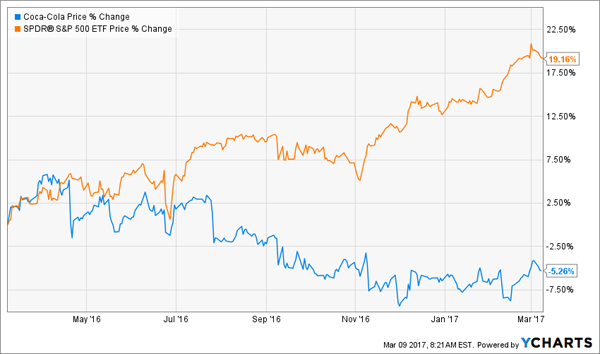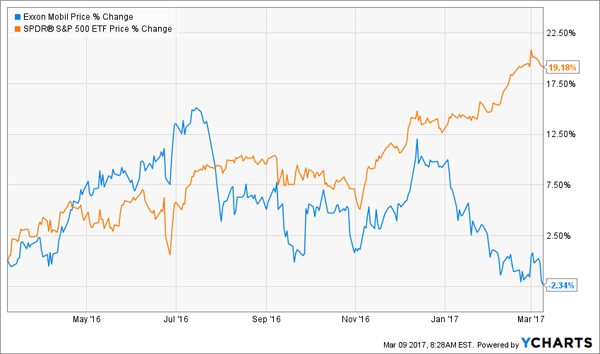In a crazy bull market like this, you may feel like it’s impossible to lose.
That’s a dangerous feeling. Because there are a few loser stocks out there—although admittedly there are far more winners than losers.
Still, if you’re holding on to one of the big loser stocks right now, you can’t be blamed for feeling bad about it. How can you be losing money when the S&P 500 is up a whopping 18% from a year ago?
You might even be thinking about giving up on stocks. You might think the market is rigged and there’s no way for anyone off of Wall Street to compete.
That, too, is dangerous thinking.
Wall Street isn’t rigged. If it is, why have so many hedge funds lost billions in the last few years and underperformed index funds? It can be a hard game to win, to be sure, and it can feel frustrating at times. But you can win.
You just need to know what to buy and what to avoid.
Sounds easy, right?
Of course, it’s not—especially when following the wise and time-tested principles of value investing doesn’t always work.
Take Warren Buffett for example. Imagine you followed his lead and bought simple companies with great cash flow and wide moats. Imagine you also focused on dividend-growth stocks with long histories of returning capital to shareholders. Companies like Coca-Cola (KO).
Well, you’d probably hate yourself if you compared that pick to the SPDR S&P 500 ETF (SPY) over the past year:
No Sugar High for Coke Buyers

That’s pretty frustrating, since Coke’s cash flow, dividend growth and valuation metrics all look pretty solid.
But the timing was poor; Coca-Cola had a huge run-up in early 2016, when the broader stock market recovered but was still somewhat risk-averse. As investors threw caution to the wind and worried less and less about systemic risks, they needed to raise cash from somewhere to buy riskier stocks. That triggered the selloff in Coke stock that started in the spring of last year and continues to this day.
The investor who held Coke made the technically correct decision to hold on a year ago. They just made that decision at the wrong time.
Something similar is happening with ExxonMobil (XOM).
One of the few energy plays to retain its Dividend Aristocrat status (or to have raised its dividend for 25 straight years or more), Exxon’s cash flow situation is not as rosy as Coca-Cola’s, and its sharply falling revenue figures are a sign of caution.
But XOM has the best financial engineers in the business, so they’ve kept the dividends coming and the profit margin positive as dividend cuts and panic selling have swept through the energy sector. In 2016, when oil prices flattened, it seemed sensible to buy Exxon. At that point, it had a P/E ratio of 21, versus a market-wide P/E of 24.
Again, sensible investing, but with disastrous results:
XOM Stays Weak

What makes this even more distressing is that WTI futures went up 45% over the same time period. That should have lifted all energy stocks! But it couldn’t save Exxon.
Now let’s make things really interesting. What if you had chosen ETFs focused on these stocks’ sectors instead? Long story short: you would’ve clearly come out a winner.
The ETF with the most exposure to Coke is the Vanguard Consumer Staples ETF (VDC). And of course, the Energy Select Sector SPDR (XLE) is heavily invested in Exxon. Yet these funds have handily beaten those stocks in the past year:
Diversification Wins Out

This doesn’t mean ETFs are better than stocks—not by a long shot.
But it does mean a diversified portfolio always beats relying on a single stock for growth. The key is to add stocks when they’re at their weakest and avoid them when they’re at their strongest.
I know that’s a tall order in today’s overbought market—which is why I recommend being very careful with the so-called Aristocrats, and avoiding Exxon and Coke entirely.
Because despite their plunges, you’re still paying more than 28 times earnings for these two dogs. And their dividend yields have only moved up to the mid-3% range.
We can do better.
How? By diving into overlooked corners of the market, like preferred shares, real estate investment trusts (REITs) and closed-end funds (CEFs). Here, yields upward of 6.0% and discounts of 15% or more are common.
You can start with the 6 bargains in our “No-Withdrawal” retirement portfolio. Combined, they throw off a safe 8.0% payout! That’s enough to generate $40,000 in income from every $500,000 you invest.
These are the perfect investments to buy in the waning days of the Trump bump, because their hefty discounts will throw a brace under their share prices when the market inevitably corrects. And you’ll still collect their hefty 8% dividends!
The time to buy these 6 smart income plays is now. Go here and I’ll give you the names, tickers and complete details on each one.
